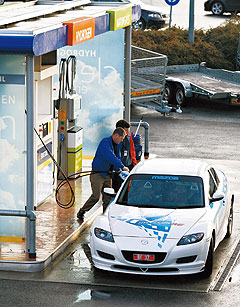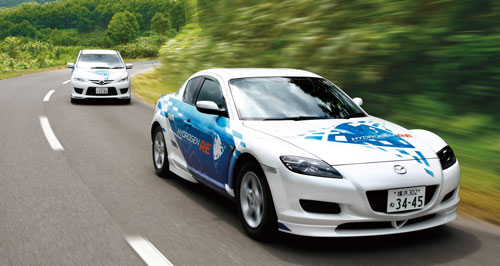Make / Model Search
News - MazdaHydrogen highwayCentre of attention: Journalists check out the hydrogen-powered Mazda RX-8 HRE in Japan. Mazda sticks with hydrogen fuel as a “solution to the post-fuel era”27 Oct 2009 MAZDA remains committed to hydrogen as a genuine long-term alternative to fossil fuels and will continue to actively develop rotary-engined vehicles powered by the volatile but renewable, emissions-free fuel. The Japanese brand is one of the world’s few car-makers to produce hydrogen-fuelled vehicles and, along with BMW and Honda, expects a currently small fleet of lease-only cars to grow into a range of publicly available models beyond 2020. In the interim, it says it will be ready with hybrid and electric vehicles if that’s what the public demands, but regards Toyota’s current focus on petrol-electric models – which comprise less than two per cent of the world’s vehicle fleet – as a marketing opportunity for a transitional technology. Mazda believes it can have a bigger impact on total CO2 emissions than hybrid vehicles by powering its next generation of lighter new models from 2011 with a range of significantly more efficient direct-injection petrol and diesel engines. It says that in 2020 most new vehicles sold globally will still be powered by internal combustion engines and that it will therefore make fuel-efficient vehicles more accessible for more motorists.  Left: Refueling the Mazda RX-8 HRE with hydrogen in Norway. Left: Refueling the Mazda RX-8 HRE with hydrogen in Norway.Mazda has promised to reduce the weight of its future models by at least 100kg, starting with the all-new Mazda2 in 2011. The current Mazda2, which itself is about 100kg lighter than its predecessor, was the first model to reverse the trend of new models being 15kg heavier on average than before, due to increased safety and specifications. “We know we can’t just keep increasing weight,” said Nobuhiro Hayama, Mazda’s director and senior managing executive officer for R&D, quality, powertrain development and electric drive system development. “From 2011 we plan to reduce weight by more than 100kg with a new platform now under development,” he said. Not content to stop there, Mazda says the next generation of its global B-car, due to emerge in 2016, will shed a further 100kg, thanks to a range of weight-saving measures, prioritised by cost. They include improved body and chassis structures through the use of computer aided design, which is expected to account for 84 per cent of weight reduction, new process such as hot stamping, hydro-forming and bonding (13 per cent), and replacing steel with new materials such as aluminium (three per cent). Combined with its new range of direct-injection petrol and diesel ‘Sky’ engines from 2011, Mazda promises that the fuel consumption of the next Mazda2, which is likely to be downsized from 1.5 to 1.3 litres, will be on par with the latest hybrids, while the next-gen Three will be as efficient as the current Mazda2. Mated to a new-generation six-speed Sky-Drive automatic transmission, the new 2.0-litre Sky-G petrol engine is claimed to increase torque and fuel efficiency by 15 per cent, while the new 2.2-litre Sky-D diesel engine will by 20 per cent more efficient. Alongside its weight reduction program, Mazda will employ a three-step hybridisation process starting with the introduction of its innovative idle-stop technology and regenerative braking system. Combined for the first time with its new 1.3-litre Sky petrol engine in the Kiyora concept at Tokyo, the technologies return fuel consumption as low as 3.1L/100km. Mazda recently announced a $3.7 billion investment in the development of technologies including hybrid and electric drive systems over the next three years and one of the results could be a production version of the hybrid drive system in the Premacy Hydrogen RE, which is powered by a hydrogen-fuelled rotary engine via an electric motor. Further afield in the “post-fuel” era, however, Mazda continues to bank on hydrogen as a sustainable automotive fuel alternative. Unlike Honda, whose hydrogen fuel cell-powered FCX Clarity is now available for lease in both Los Angeles and Japan, Mazda and BMW believe hydrogen is best used as an internal combustion engine fuel rather than as a means to generate electricity to power EVs. Mazda began developing fuel-cell vehicle technology in 1991 and was the first maker to test an FCV on public roads in Japan, but says the technology continues to be limited by cost and reliability. “Vehicles powered by hydrogen emit only water,” said Mazda’s hydrogen vehicle program manager, Akihiro Kashiwagi. “There are two ways to extract energy from hydrogen: combust it directly in an ICE (internal combustion engine) or extract power from itMr Kashiwagi said that while both processes were emissions-free and that fuel cells are more energy-efficient, hydrogen-powered ICE vehicles are more reliable and cheaper to produce because they can also run on petrol with minor modifications. “Mazda is not denying fuel cell technology at all,” Mr Hayama said. “There are good points for fuel cells and areas that need improvement and we fully understand those areas. “(But) Fuel cell technology is very costly because it uses lots of precious metals, so physically it’s impossible to convert all vehicles globally into fuel cell vehicles because of the availability of precious metals in the world. So unless we resolve this it will take much longer to become a mainstream technology. “Secondly, fuel cells require hydrogen with a purity of more than 99.9 per cent, which has to be produced with very special equipment. But to combust it in an internal combustion engine it only needs to be 70 per cent pure. “So the internal combustion engine is a more practical alternative than fuel cell,” said Mazda’s R&D chief, who added that although vehicles powered by either hydrogen or electricity both required a new refuelling/charging infrastructure, electric vehicles were currently more limited in application than hydrogen-fuelled cars. “Clearly, creating a hydrogen fuel infrastructure is much more difficult than a plug-in power infrastructure, but current battery technology means EV technology has its limitations at this moment,” he said. “There is no point having infrastructure if it doesn’t respond to the needs of customers.” He admits that the limited number of hydrogen fuel outlets – just 16 in Japan and eight in Los Angeles – remains the show-stopper for hydrogen-powered vehicles, but points out that dual-fuel systems such Mazda’s all but eliminate the issue of running out of fuel. While Honda has committed to leasing 200 examples of its FCX in Japan and the US, Toyota has promised to make every model line available with hybrid power by 2020 and says it will release its first fuel cell vehicle by 2015 – essentially be replacing petrol engines in hybrid vehicles with fuel cell stacks. Some analysts believe fuel-cell vehicles will prove more popular than plug-in electric vehicles by 2050, while others say EVs will become the choice of vehicle for city dwellers while FCVs will be employed primarily for longer-distance travel. Either way, with large numbers of EVs circulating mega-cities in developing nations that currently produce almost all their power from brown coal, Mazda believes hydrogen is the cleanest option to reduce CO2 emissions – whether it is employed in fuel cells or internal combustion engines. Mazda also claims its trademark rotary engine is better suited to running on hydrogen fuel than conventional piston engines because its separate combustion and intake chambers significantly reduce heat – one of the most critical issues with any hydrogen vehicle. “Hydrogen is very combustible compared to petrol, so abnormal combustion occurs,” says Mr Kashiwagi. “The intake and exhaust chamber is the same in a normal reciprocating engine, but in a rotary they are separate, so abnormal combustion doesn’t occur easily. The rotary is therefore better suited to hydrogen combustion and was the primary reason it was adopted as our base hydrogen engine.” The company’s global sales chief says that, hydrogen-powered or not, rotary engines will continue to be a “core” technology of the Mazda brand. “In the future the rotary will continue to be the symbol of Mazda,” said Masazumi Wakayama, senior managing executive officer for global sales and customer service, at last week’s Tokyo motor show. “We are also envisaging the next generation rotary engine as part of our product development plan. So at this moment we don't plan to discontinue the rotary engine. There are still lots of evolution possibilities for the rotary engine in the future,” he said. Mr Wakayama said he joined Mazda in 1967, two years after the release of the company’s original rotary-powered Cosmo grand tourer, because he was inspired by Mazda’s rotary ambitions. “I joined Mazda just because of my passion to work with someone who’d developed such an engine,” he said. “Many employees like myself feel that way. It’s a very strong feeling ingrained in the heart and spirit of Mazda.” Mazda has committed to producing a replacement for its current rotary engine, which powers both the four-door RX-8 coupe and both of the company’s rotary-engined (RE) hydrogen vehicles – the Premacy people-mover and RX-8 sportscar. In further good news for Mazda performance car fans, the Japanese maker says it will not abandon its sports-oriented MPS vehicle line, which comprises only the turbocharged Mazda3 MPS hot-hatch. “We will keep producing products that embody Zoom-Zoom,” said Mr Wakayama. “That's the commitment we have made. MPS is one of the symbolic models of the Zoom-Zoom strategy. Zoom-Zoom is not an advertising campaign,” he said. Mazda won’t say which model will be next to receive the MPS treatment, or whether the previous-generation Mazda6 MPS will be replaced.  Read more |
Click to shareMazda articlesResearch Mazda Motor industry news |












Facebook Twitter Instagram